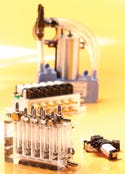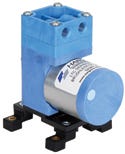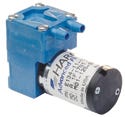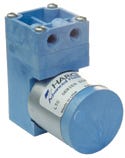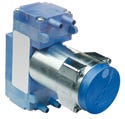Portable Devices: Optimizing Diaphragm Pumps and Solenoid Valves
An increase in portable devices means a need for smaller—sometimes tailored—components such as pumps and valves.
March 1, 2008
PUMPS AND VALVES
|
Miniature diaphragm pumps and valves can be tailored to meet market objectives. Photo by RONI RAMOS |
The increased demand for medical therapies and treatments to be administered at home—or even on the go—has sparked a new generation of portable devices. Many of these systems incorporate fluidic modules consisting of miniature diaphragm pumps and solenoid valves.
These components need to be optimized according to the system criteria that best achieve the market demand objectives. Medical device developers benefit from understanding how these components can be tailored to meet their application-specific requirements.
Healthcare Market Drivers
Pressures from payers and employers to contain healthcare costs have been associated with the shift to less-costly outpatient procedures. Procedures that were once performed only on an inpatient basis are increasingly performed in a variety of outpatient and ambulatory (when a patient must travel to a location to receive services that do not require an overnight stay) settings. Advances in medical technology and the development of noninvasive and minimally invasive surgical procedures have contributed to this growth in outpatient ambulatory care.
The trend for medical practitioners to have patients reduce hospital stays and continue treatments at home has required medical device companies to engineer systems that are portable, quiet, and cost-effective. Several high-technology diagnostic and therapeutic services now available in the home include transfusion therapy, dialysis, oxygen therapy, mechanical ventilation, compression therapy, and wound therapy.
This changing healthcare landscape is driving explosive growth in the medical device field.1 The market will continue to accelerate as demographics and market drivers increase their pressure for new and innovative product offerings.
To successfully support an increased speed to market of new and innovative products, medical device companies are finding great value in working closely and earlier in the development process with component suppliers to identify key system requirements. Miniature diaphragm pumps and solenoid valves, for example, have become popular with fluidic-systems engineers to provide pressure and vacuum transport of air and gas in a cost-efficient manner. By understanding how key components such as these can be tailored for optimum system performance, medical device developers can speed their time to market by identifying early exactly what they need.
Identifying a System's Performance Criteria
The marketplace for portable medical devices is becoming more segmented and competitive, with each segment offering different features to meet specific end-user demands. The first step in the development process should be to get a clear definition of the criteria for a successful product release from the marketing team. Then, it is important to prioritize these capabilities and select the components and the respective performance specifications needed to best meet the ranked criteria. Because there are usually trade-offs, this step helps to ensure that major product objectives are met and that development timelines don't suffer from project scope creep. Scope creep refers to the tendency of a product's objectives to broaden as the program moves forward.
For portable medical device developers, the following criteria—and how they are prioritized—can make significant differences in the specific components that should be selected.
|
The compact design of a pump for liquid operations can enable it to operate longer than previous pump designs. |
Size and Weight. For medical devices to be truly portable, they need to be much more compact and lighter than their desk-mounted predecessors. The maximum envelope that the fluidic module can fit into needs to be determined. The fit of the module affects the maximum size of the pump and valves that will determine fluidic performance. If space is limited, smaller pumps and fewer valves are needed. Be aware, however, that using small pumps can either limit performance or increase noise. Smaller pumps must often run at maximum motor speeds to achieve similar performance of a larger pump that is run at a slower speed.
Performance. Another key parameter is the required flow at pressure and vacuum at the critical operational points of the medical therapy. It is important to understand how the pressure and vacuum is controlled (analog control, pulse width modulation [PWM] control, PWM with tachometer output, etc.). How they are controlled should be determined to set baselines for key components.
Increasing the performance while shrinking the size of the miniature solenoid valves and diaphragm air pumps has posed several interesting challenges. Advanced designs, materials, and motor technologies have launched new, innovative pumps and valves that can achieve better performance in a smaller package.
Noise. Some medical therapies must account for noise. Such therapies include devices that operate next to a sleeping patient or those that are used in public. Diaphragm pump manufacturers minimize noise by reducing the stroke, optimizing diaphragm shape and durometer, and lowering chamber inefficiencies. Depending on the level of these actions, trade-offs may affect pump efficiency and fluidic performance. Another tactic noted earlier is to use a larger capacity (e.g., a dual-head pump versus a single-head pump) running at a lower rpm. The performance stays the same but the noise level drops significantly. The trade-off, of course, is a larger pump envelope.
|
New valves have been designed to provide increased flow and to reduce power consumption. |
Efficiency. For a battery-powered device, the designer must determine the desired target operational life from the battery. One consideration is whether there would be a market advantage to having the portable medical device run longer from a battery than its competition. As discussed in more detail later, the proper selection of motor technology for the diaphragm pump contributes greatly to the efficiency of the system. In addition, properly matching the orifice size of the solenoid valves ensures that they are not acting as a restriction, which would force the diaphragm pump or miniature compressor to work harder.
Operational Life. A key consideration is whether the device is disposable or requires the fluidic components to run intermittently. Another consideration is whether the pump requires proven high reliability under demanding cyclic operation that can exceed 10,000 hours of operational life. Operational life requirements are affected by selection of the motor technology, diaphragm elastomer, and fluidic loads and cycling, in addition to the maximum temperature environment to which the components will be exposed.
Cost. When cost is placed on the decision criteria for fluidic components, it greatly affects the ability to maximize the advantage of each of the preceding factors. It should be noted that too strong an emphasis to cut costs of the diaphragm pumps and solenoid valves could actually increase overall costs and decrease marketability of the device. For example, advanced, high-efficiency and high-reliability motor technology and solenoid valves significantly decrease power consumption—sometimes in half. Such a decrease in power consumption can result in battery requirements being greatly reduced, giving development engineers the flexibility to design an even lighter and more-compact device or elongating battery capacity.
The following technology drivers greatly affect the criteria for selecting miniature air diaphragm pumps and miniature solenoid valves.
Dc Motor Selection
The motor of the miniature diaphragm vacuum pump or compressor is probably the biggest driver affecting the overall performance, efficiency, expected operational life, and cost. Because the motor is the highest-cost component of a diaphragm pump, it significantly affects the overall cost of a fluidic module. Two major motor technology designs, dc brush and dc brushless, can be configured on the pump. Each has respective advantages and disadvantages.
Brush Dc Motors. Dc brush motors are commonly used with many diaphragm pressure and vacuum pump applications when low cost is critical but operational life is not important. Iron core brush motors use carbon brushes to conduct the electrical input from the lead wires to the motor's commutator. The constant rubbing of the brushes on the commutator causes the brushes to wear down much like the lead in a pencil. Brush motors are designed to last from 500 to 5000 hours, depending on the quality of the motor and how it is used.
The motor brushes experience an electrical arcing upon each startup. Frequent arcing heats up the carbon brushes, causing them to wear out more rapidly. Therefore, brush motors that experience frequent on-off cycles wear out more quickly. A top-quality brush motor can be expected to last no more than 3000 hours with frequent on-off cycles. Brush motors used in high-duty applications with more-continuous operation can last longer.
It is important to note that few applications allow a pump to run continuously. Frequent starts and stops are the norm. Occasional cycling may lead to motor stall due to carbon dust buildup between the brush base and commutator. Tapping the outer housing to clear these deposits from the brush tips can usually restart the motor. In addition to limited life, brush motors can introduce unwanted electrical or radio-frequency interference noise into a system's circuitry.
Coreless motor technology differs from a standard brush motor in that the winding is wound onto itself on the rotor. The brushes are made from a highly conductive and efficient precious metal. No iron is on the rotor, making the lighter, coreless (or ironless core) rotor spin at a given performance level with less input energy required. This design results in lower current draw required to power the respective diaphragm pump. Coreless motors come at a premium price because of the precious-metal brushes and the complexity to manufacture the wound rotor. As a result, coreless motors are commonly used in portable, battery-operated systems that require exceptional efficiencies to achieve longer battery operation, but do not require an operational life greater than standard brush motors.
|
Coreless dc motor-driven pumps for air and gas allow designers to reduce size and weight. |
Advances in Brushless Dc Motors. Brushless dc motors eliminate the problems associated with brush motors. In a brushless motor, the magnets are on the rotor, and the windings are wrapped around poles on the stator. Instead of brushes and a commutator bar, the windings are switched on and off sequentially by solid-state electronics. Brushless motors require less maintenance and are smaller, lighter, and more efficient than brush motors with comparable outputs. With motor designs that focus on performance, reliability, and endurance, operational life can be expected to exceed 10,000 hours. A high-precision bearing cage design takes out any play that causes bearing fretting. This precision design can also produce a quieter motor because the mechanical noise common with brush motors is significantly reduced.
One limitation of traditional brushless motors, however, is that they do incorporate slotted stators. The stator consists of slotted iron laminations that are fused to form a solid, uniform stack. The slots form rows that extend the length of the stack, and the windings are inserted into each row. As the rotor turns, the magnets are more attracted to the stator's teeth than to the gaps between them. This uneven magnetic pull, called cogging, reduces the motor's efficiency and makes it difficult to produce smooth motion at low speeds. With typical operating pressure and vacuum loads, current-
technology brushless motors can see efficiencies in the 50–60% range.
A new design variation is a brushless motor that incorporates a slotless stator (one that has no slots to keep the windings in place). The windings are attached to the inside surface of the stator with adhesive. With no teeth to attract the magnets, cogging is eliminated, and the motor produces smooth, quiet rotation. The absence of teeth also provides room for larger magnets in the rotor and more wire in the windings, which means that slotless motors can generate more torque without a corresponding increase in size. Additionally, the slotless design significantly reduces damping losses.
|
New valves have been designed to provide increased flow and to reduce power consumption. |
In both slotted and slotless motors, eddy currents are induced as the magnets pass the stator. However, these currents are weaker in slotless motors, because the distance between the stack and the magnets is greater than in slotted motors. This makes slotless, brushless motors more efficient than slotted motors. Compared with slotted brushless motors, miniature-diaphragm pressure and vacuum pumps can expect to see improved efficiencies of up to 70% coupled with the exceptional life that the brushless design produces.
Diaphragm Pumps: Innovative Materials and Shapes
The diaphragms in miniature diaphragm pumps and microcompressors are stretching and flexing under load, and sometimes at elevated-temperature conditions. Ethylene propylene diene monomer (EPDM) elastomers have limited elastic properties to withstand the cyclic stretching required for high-flow-output applications. Therefore, many current- technology miniature diaphragm pumps and compressors are only rated up to 40°C and are unable to endure the rigorous cyclic stretching required for higher-output applications. Pumps configured with EPDM and operating at higher ambient environments typically endure ripped diaphragms before they achieve 3000 hours. To extend diaphragm life past 10,000 hours under operating conditions that the latest portable medical devices require, an advanced-performance elastomer with improved mechanical capabilities has been developed that can withstand 70°C. Extensive research was conducted that resulted in the development of this advanced EPDM, or AEPDM. This elastomer material configuration has been tested to last 10 times longer than standard EPDM. Depending on the fluidic loads and ambient operating temperatures at which the miniature diaphragm pump is operating, AEPDM diaphragms have been found to exceed 20,000 hours of operational life.
|
Pumps can now be easily configured to accommodate specific vacuum and pressure requirements. |
The shape of the diaphragm itself has been evaluated and optimized to improve vacuum, pressure, and flow performance efficiencies. The performance of typical flat diaphragms is limited by the amount that the diaphragm can be stretched. High-performance air and gas pumps require increased pump stroke beyond the stretch limits of the flat diaphragm. Higher vacuum or higher flow performance for these flat diaphragms requires that either a larger flat diaphragm be used (which would require a larger pump head design) or that a shaped diaphragm be used to provide an increased surface area. Shaped diaphragms allow the pump stroke to increase by as much as 80%. By optimizing the pump's diaphragm shape, significantly increased output performance can be achieved in a much smaller, compact envelope size.
Higher Flow: Larger Valve Orifice, Not Larger Pump
Miniature solenoid valves are required to direct and control the flow in many portable medical devices that require miniature diaphragm pumps or microcompressors. The valves typically cannot exceed a 10-mm package size because of the enclosures being used today. The latest design trends have challenged component manufacturers to produce smaller, lighter components, specifically miniature solenoid valves, to accommodate ever-smaller products. As valves decrease in size, they have smaller orifices and restricted throughput, effectively giving up higher performance for a smaller package. The typical 10-mm solenoid valve has up to 1⁄6th the throughput area compared with the pump output capacity.
The restrictions of these small, ineffective valve orifices, therefore, require the pumps in a fluidic system to overcome significantly large pressure differentials. To compensate for this reduction in throughput, fluidic systems engineers commonly use a pump with up to 200% more capacity than necessary. Even with the pumps that provide higher output, minimal performance gains are achieved while adding unnecessary weight, and increased power consumption, as well as increased heat, noise, and size. Additionally, as portable medical device designers develop smaller instruments with more functions, more solenoid valves are required, which compounds the increased heat, noise, and power-
consumption problems.
Recent advances in solenoid valve technology have focused on decreasing the overall size of the valve but increasing the size of the orifice. Finite-element analysis can be used to study the fluid flow throughput and the flux efficiency of the magnetic field created by the solenoid. Such analysis should enable the development of new designs that provide flow of up to two times the current capabilities. In addition, improved efficiency in the solenoid design significantly reduces power consumption and heat generation.
Advanced manufacturing processes can lock in exact, optimized orifices that enable fluidic tailoring to achieve application-specific flow. The new miniature solenoid valves can be mounted individually, mounted on a manifold, or soldered directly onto a printed circuit board.
Conclusion
Typically, the weak link in a fluidic circuit has been the small valve with its small, restrictive orifice. Instead of specifying larger, higher-output pumps, fluidic designers are working with providers to explore tailored options that optimize the solenoid valve orifice to a diaphragm pump to best meet their system criteria. Advantages include smaller, lighter pumps that produce less noise. Differential load pressures, overall size, and weight are decreased.
Portable medical devices increasingly seek to achieve higher flow, longer battery operation, and longer device life. Smaller but more-cost-effective fluidic modules can provide tailored configurations of advanced miniature diaphragm pumps and valves. Properly ranking the overall system criteria and the respective component requirements is essential to ensuring project success and quick time to market.
Dan Schimelman is director of business development at Hargraves Technology Corp. (Mooresville, NC). He can be reached at [email protected].
Reference
1. “Consumer Medical Devices Market to be Worth $5 billion by 2011, says InMedica” (Belmont, CA: Tekrati, February 4, 2008) [online] cited 22 February 2008; available from Internet: http://industry.tekrati.com/research/10003/.
Copyright ©2008 Medical Device & Diagnostic Industry
About the Author(s)
You May Also Like
